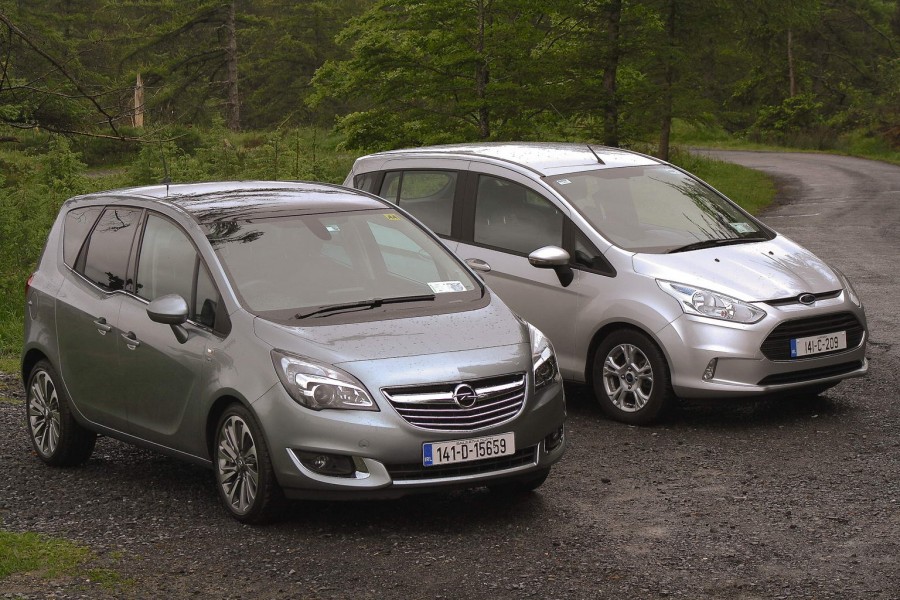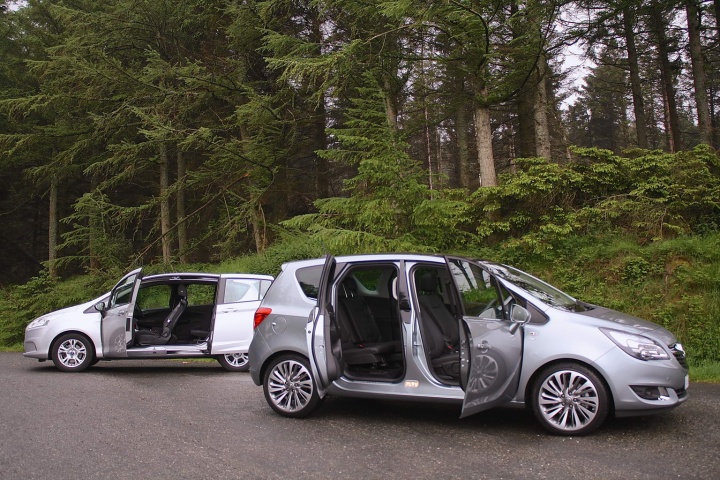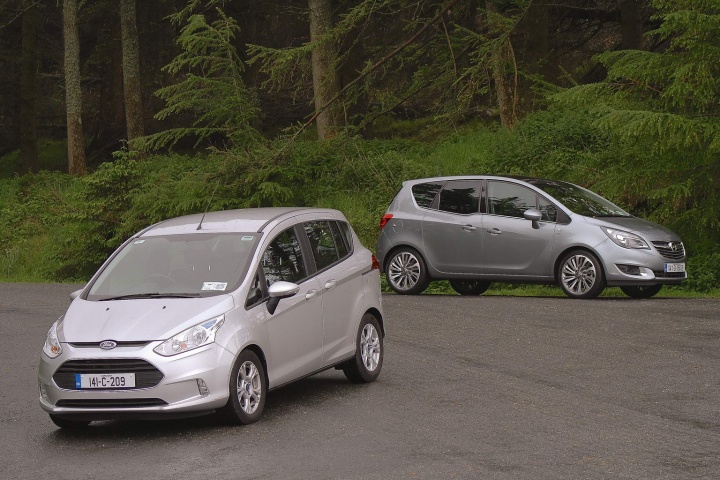Opel's Meriva mini-MPV can be had with a truly modern compact diesel engine. But can it beat Ford's clever sliding-door B-Max?
In the Metal
You do not buy a mini MPV if you are looking for style, that much is clear. Sadly, the purchase of such a car is generally a sign that you've given up on having a social life and are now settling grumpily down for a life of being a kids' taxi and a general adult dogsbody.
Kudos then to both Ford and Opel for making both the B-Max and the Meriva genuinely decent to look at. No, neither is going to be an optical rival for a Ferrari 250 GTO, but equally neither is as boxy or unattractive as they could so easily have been. The mild exterior tweaks Opel made to the Meriva a couple of years ago kept an already decent looking car fresh (the new lights are nice, as is the tweaked grille and the black-glass effect on the tailgate). I generally dislike unnecessary kinks or changes of angle in the window line (it usually looks too fussy), but as we'll see that makes a big difference on the inside, so I'll give it a pass here.
If the B-Max is a little more quiet-looking than the Meriva then it's still quietly handsome, with plenty of cues from the smaller, sexier Fiesta, including that Aston-Martin-style grille. The cutlines for the sliding rear doors look a touch awkward, but generally the Ford does an equally good job as the Opel at avoiding unnecessary square-ness.
Inside, there is a much greater divergence between the two. Now, there was a significant specification gap between both cars (more on which in a little while), but even so, it's clear that the Ford has the darker, less inviting interior. It's mostly to do with the way the side glass is arranged. In the Ford, the side of the car features a rising beltline for a more aggressive, wedge shape, but that just destroys any chance light has of getting into the cabin.
In the Opel, that kink in the door line not only helps those inside see out better (especially the sort of small people you're most likely to be lugging around back there), it also lets more light in. Our (admittedly pricey) SE version also comes with a full-length panoramic glass roof, which again allows a positive flood of light into the car. It makes a big difference to the ambience, especially on long journeys.
The Opel also has the better interior quality. The Ford feels well made and bolted together but it can't quite match the feeling of heft and solidity that the Opel possesses. You can really start to see Opel's gentle drift upmarket relative to Ford when hopping between the two cars. The B-Max feels like a well-executed mass-market car. The Meriva is starting to verge on feeling like a proper premium model. Both, it should be said though, offer exceptional long-haul comfort with the Ford just edging it on overall seat comfort and support.
Of course a big reason for buying either is the inclusion of clever doors. The whole side of the Ford really does open up when you slide back the rear doors and open the fronts at the same time, and there's no central pillar to impede access. Space is simply not an issue and the sliding doors are terrific in tight car parks.
The Opel's doors, with the rear ones opening backwards like a taxi or a Rolls-Royce, are initially less clever, with a big B-post between them. They do open impressively wide though, and if you're putting child safety seats into the back, the Meriva's doors allow you to do so with less turning and twisting. The Opel also has the bigger boot - a volume of 400 litres plays the 318 litres of the Ford.
Driving Them
If you thought there was a gulf between these two cars in their spec levels (and there really, really is) then wait till you see the gap between how they drive.
The Ford puts in a strong early performance. Its steering is beautifully weighted and resolved and there is an almost surprising level of feedback for a car that is supposed to be a humble family hauler. The ride quality is also excellent, continuing Ford's long tradition of giving its cars a firmly-damped but progressive set of springs. The only problem comes when you start to feel the weight. At 1,200-odd kilos, the B-Max is no Slim Jim and the particular problem seems to be with the way the weight is distributed. Those clever doors come with both hefty latches so that the front and rear doors can be opened independently, and much strengthening material so that the car can do without a B-pillar. The upshot is extra weight and much of it up high, where you don't want it. That means that the B-Max can start to feel a touch ponderous in corners, which is a shame.
The Opel at first simply isn't as good to drive. Its steering is not as sharp and its ride is less well resolved. Spend some time with it though and it does start to come together rather nicely. It has excellent cruising qualities, so if you do lots of long motorway miles, this is the one to go for, but its true trump card is its engine.
The old Opel 1.7-litre diesel was, let's face it, dog-rough - noisy, unrefined and prone to low-rev stalling. Thankfully Opel's new and very modern 1.6-litre replacement is a massive improvement. It can still sound a bit grumbly and noisy at low speeds, but it shuts up a lot once its warm and it's powerful. Outputs of 136hp and 320Nm of torque simply annihilate the weedier 75hp and 185Nm of torque that the Ford can offer. And this isn't just a spec thing. While you can get a lower-powered Meriva, this is the only diesel engine the B-Max is offered with.
The Ford's 1.5 TDCi engine does hit back with much better refinement though. While the Opel engine is a big aural improvement on what went before, I'd say that the Ford engine is one of the most silent diesels I've ever sat behind. It just needs more poke.
What you get for your Money
Our Meriva was staggeringly expensive for a small car at €29k including all the options fitted to it (€1,400 worth of satnav alone). Even given Opel's premium ambitions, that still seems like an awful lot of money to spend on a compact family car. The Ford's price is much more palatable, but then you do have to do without a big, colour central screen, a USB hook-up for your smartphone, split-zone climate control and so on. There's also the fact that you can get a basic Meriva for less than the cheapest B-Max. The Ford offers better value overall, we'd say, but Opel offers you far more choice and opportunity for tailoring the Meriva's specification.
Summary - Neil Briscoe
The B-Max puts up a good fight here. Its sliding doors are potentially more useful, especially if you park regularly in city centres, and its steering and suspension are right up there with the best, as is its refinement. The Opel, though, comes through to win. Yes, our test car was a pricey, highly specified version, but the essential talents of the car are simply superior. The doors are overall more useful, it's more spacious, has a brighter, airier cabin and a greater feeling of quality. Plus, that 1.6-litre diesel engine is a cracker, a potential class leader.
Second Opinion - Shane O' Donoghue
I really thought Neil would be swayed by Ford's as ever polished dynamic package and if not by that by the lower pricing of the B-Max. However, I have to agree, as a father of two small kids, the Meriva proves to be a far handier car, at times feeling like it's a class above the B-Max. I disliked the first Meriva intently, but this is one I'd gladly call my own. The B-Max isn't bad at all, but I'd take the Opel without hesitation.
Opel Meriva Tech Specs
Model tested: Opel Meriva 1.6 CDTi SE
Pricing: €29,105 as tested (starts at €19,995)
Engine: 1.6-litre turbocharged four-cylinder diesel
Transmission: six-speed manual, front-wheel drive
Body style: five-seat, five-door mini-MPV
CO2 emissions: 116g/km (Band A4, €200 per annum)
Combined economy: 65mpg (4.4 litres/100km)
Top speed: 197km/h
0-100km/h: 9.9 seconds
Power: 136hp at 3,500rpm
Torque: 320Nm at 2,000rpm
Ford B-Max Tech Specs
Model tested: Ford B-Max 1.5 TDCi 75
Pricing: €21,932 as tested (starts at €21,932)
Engine: 1.5-litre turbocharged four-cylinder diesel
Transmission: five-speed manual, front-wheel drive
Body style: five-door, five-seat mini-MPV
CO2 emissions: 109g/km (Band B3, €190 per annum)
Combined economy: 68.9mpg (4.1 litres/100km)
Top speed: 158km/h
0-100km/h: 16.5 seconds
Power: 75hp at 3,750rpm
Torque: 185Nm at 1,700rpm















